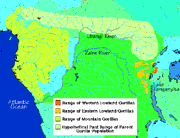

|
|
 Biology BiologyClassification and Range Carl Linnaeus devised the classification system in zoology that we use today. In this system, humans and the three categories of great apes (chimpanzees, orangutans, and gorillas) all belong to the order Primates. Gorillas, the largest of the great apes, are divided into three subspecies: (1) western lowland gorillas (Gorillas gorilla gorilla), (2) eastern lowland gorillas (Gorilla gorilla graueri), and (3) mountain gorillas (Gorilla gorilla beringei). The three gorilla subspecies are very similar and show only minor differences in size, build, and coloring. The approximate ranges where each of the subspecies lives are shown on the map of Central Africa. The eastern and western groups of gorillas are widely separated in location, but so similar in form that they must have come from a single parent population in the not too distant past. Since gorillas will not cross large rivers, such as the Zaire and Ubangi, the eminent gorilla specialist George Schaller suggested that the parent population probably lived in the area shown on the map. Today, most of this hypothetical range is too dry and open to be a suitable gorilla habitat, but during cooler and rainier conditions that existed 5000-7000 years ago, the area would have been covered by a rainforest where the gorillas could have lived. Population The world's gorilla population is relatively small and still declining. All three gorilla subspecies are listed as endangered by the U.S. Fish and Wildlife Service and by the Convention on International Trade for Endangered Species. There are currently about 50,000 western lowland gorillas living in the wild in West Central Africa. This gorilla is also the type most often seen in zoos. The eastern lowland gorilla population has declined significantly in recent decades. An estimated 5,000-15,000 lived in the eastern Congolese rainforest around 1960. Today only about 2,500 remain in the wild, and only a few dozen live in the world's zoos. The mountain gorillas are the rarest of all and are on the verge of extinction. Only about 600 of these magnificent animals are left in the wild, about 320 in the Virunga Mountains and another 300 in the Bwindi Impenetrable Forest National Park in Uganda. None are found in captivity. The population of mountain gorillas in the Virunga Mountains has been watched closely for the last half-century and shows the effects of human interaction, both good and bad. George Schaller estimated that about 450 mountain gorillas lived in the Virungas in 1960. Hunting and poaching reduced their numbers to about 250 by 1981, when the protection efforts of the late Dian Fossey and others brought the decline to a halt. Today about 320 mountain gorillas inhabit the Virungas, but their long-term survival continues to be threatened by natural changes and disasters, hunters and poachers, and the chronic political instability that swirls around the edge of their forest home. Life Cycle of the Mountain Gorillas Newborn gorillas are small, covered with black hair, and weigh about 2.3 kg (5 lbs). They must be cared for at all times. By age two they are able to reach and chew on vines and branches. They develop about twice as fast as human babies.
Females mature at about age six and cease to grow taller, although they continue to gain weight slowly until they reach weights of 113-136 kg (250-300 lbs) at ages of ten to eleven years. Males continue to grow both in size and weight past the age of six; they do not reach maturity until they are about ten years old. Between the ages of about six and ten years, males retain the uniformly black hair color of their youth and are called blackbacks.
The maximum life span of mountain gorillas in the wild is difficult to estimate. The longest-lived gorillas in captivity reached ages of thirty to thirty-five years. No gorilla has been seen in the wild that looked as aged as the oldest captive gorillas, so the life span in the wild is probably somewhat less, perhaps twenty-five to thirty years.
[ Home ] [ Teacher Pages ] [ Modules & Activities ] |
HTML code by Chris Kreger
Maintained by ETE Team
Last updated April 28, 2005
Some images © 2004 www.clipart.com
Privacy Statement and Copyright © 1997-2004 by Wheeling Jesuit University/NASA-supported Classroom of the Future. All rights reserved.
Center for Educational Technologies, Circuit Board/Apple graphic logo, and COTF Classroom of the Future logo are registered trademarks of Wheeling Jesuit University.